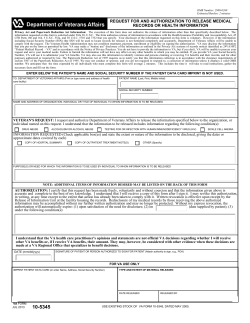
November 7th, 2014 We have today at
November 7th, 2014
We have 1 Action Item today at Issue 1
Summary of Issues
At Issue 1. we see Lame Ducks Fly to Washington. The elections may be over, but
before all the new congressional faces take office Congress will have to return to
Washington for a one month lame duck session beginning on Nov. 12. In this short time
period, legislators must address a number of unresolved issues. Most important to MOAA is
for the Senate to consider several key amendments to its version of the defense
authorization bill. See Issue 1 below for the details and to send messages to our
Senators. GF)
At Issue 2. we see How Will the Election Affect You? How will the outcome of the
elections affect MOAA’s lobbying efforts on behalf of the military and veterans’
communities? (See Issue 2 below for the details. GF)
At Issue 3. we see Fewer Vets on the Hill. The number of veterans serving on Capitol Hill will
continue its long decline when the 114th Congress convenes next year. (See Issue 3 below for the
details. GF)
At Issue 4. we see Disabled Vets Not "Milking" System. MOAA President Vice Adm.
Norb Ryan, USN (Ret) took issue with a recent Washington Times article titled Veterans
caught triple-dipping on benefits. Read his letter to the editor in response to the
allegations.(See Issue 4 below for the details. GF)
At Issue 5. we see VA Launches Choice Card. The VA announced that all enrolled
veterans will soon receive a card to receive private health care. However, not all veterans
will be eligible for the program. (See Issue 5 below for the details. GF)
Collectively We Can and Are Making a Difference
FOR ALL, Please feel free to pass these Weekly Legislative Updates on to your group
of Veteran Friends –
don't be concerned with possible duplications - if your friends are as concerned as we
are with Veteran issues, they probably won't mind getting this from two or more friendly
sources
ISSUES
Issue 1. Lame Ducks Fly to Washington
November 7, 2014
Before all the new congressional faces take office as a result of the mid-term election
upheaval, Congress will have to return for a lame duck session beginning on Nov. 12 to
address a number of unresolved issues.
What’s on their plate? The most important issues include:
-
Approving funds to keep the government running beyond December 11
-
Passing a defense authorization bill for our wartime military
-
Working on a bipartisan debt reduction package to eliminate or reduce the across-the-board
cuts of sequestration scheduled to return in 2016
There’s general consensus that Congress won’t let the government shut down, and will
probably pass temporary funding through next January or February. MOAA believes the
Senate must address the defense authorization bill, and fully consider many of the 200 plus
pending amendments. These amendments would address many important issues,
including:
-
Providing a full 1.8 percent military pay raise in 2015
-
Blocking Pentagon-proposed housing allowance reductions
-
Blocking dramatic TRICARE Pharmacy copay increases
-
Expanding concurrent receipt for disabled retirees
The Senate may decide not to consider any of these amendments and instead pass an
abbreviated version of the bill with minimal debate. This would follow what the Senate did
last year, which prevented a vote on number of MOAA-supported amendments. MOAA
feels that the Senate must have a proper debate to fully consider the defense bill and all of
its amendments.
Send your senators a MOAA-suggested message urging them to take action during the
lame duck session.
(Click on MOAA-suggested message here or above to see the summary for all states
and legislative districts. GF)
Issue 2. How Will the Election Affect You?
November 7, 2014
Many MOAA members are already asking how the mid-term election results are likely to
affect MOAA’s efforts on the Hill.
While changes in party control can bring significant changes in Congress’ priorities,
MOAA works hard to maintain good working relationships with legislators on both sides
of the aisle. In that regard, leaders of the Armed Services Committees, in particular,
often share a common view on the kinds of “people program” initiatives MOAA supports.
So the change in leadership responsibilities may have less of an impact in those areas
than in many other committees.
The real battles are usually fought over funding. Continued concern over the budget is
going to make resisting disproportionate defense cuts a significant challenge in 2015,
regardless of which party is in charge.
The latest election results combined with a number of retirements mean the military and
veterans community will be losing some legislators who have been among the strongest
supporters of military personnel issues in the past, including:
House Armed Services Committee Chairman Howard “Buck” McKeon (R-Calif.), a
long-time champion of military pay and health care. He had a hand in stopping many
of Pentagon’s recent proposals to balance the defense budget on the backs of
servicemembers and their families. He was a recipient of MOAA’s Arthur T. Marix
Congressional leadership award in 2012.
Senate Armed Services Committee Chairman Carl Levin (D-Mich.), provided
leadership in securing much-needed initiatives to assist wounded warriors and their
families, expanding eligibility for combat-related special compensation, and enacting
the first step to ease the deduction of VA survivor benefits from military SBP
annuities. Levin was a 2008 MOAA Marix award winner.
Sen. Saxby Chambliss (R-Ga.) was instrumental in winning legislation to authorize a
reduction in the reserve retirement age based on the member’s active duty service.
Chambliss was also a 2008 MOAA Marix award winner.
House Veterans Affairs Committee Ranking Member Michael Michaud (D-Maine), a
champion of VA advanced appropriations.
Sen. Kay Hagan (D-N.C.) sponsored an amendment in this year’s defense bill to
block increases in TRICARE pharmacy copays.
We will miss these legislators, as well as the strong support of their staffs. MOAA
thanks them for their dedicated service to the men and women in uniform, and wishes
them well in all of their future endeavors.
Issue 3. Fewer Vets on the Hill
November 7, 2014
The decline of the total number of veterans serving on the Hill will continue when the newly
minted 114th Congress takes office next year.
In the House, the percentage of members who served in the uniformed services slipped to
18.6 percent – the lowest level since before World War II. Only 81 veterans (80 voting
representatives and 1 non-voting delegate) will return to Washington in January. A total of
87 (20 percent) representatives had served in uniform at the start of the 113th Congress.
The number in the Senate will increase slightly to 20 veterans (20 percent), one more than
the number that took office at the start of the 113th Congress.
Total representation in the 114th Congress falls from 20 percent of legislators to 19 percent.
The representation of veterans in Congress has declined steadily since it peaked at 74
percent for the House (1969-70) and 78 percent for the Senate (1977-78).
Some of the decline can be explained by an inevitable demographic shift. The 114th
Congress could be the first without representation from the Greatest Generation (pending
the result of one run-off). However, the number of Operation Enduring Freedom and
Operation Iraqi Freedom veterans serving in Congress continues to grow with 22 heading to
the Hill in 2015.
Issue 4. Letter to the Editor: Disabled Vets Not
"Milking" System
By THE WASHINGTON TIMES - - Tuesday, November 4, 2014
I take issue with the characterization of severely disabled veterans (those with disability ratings of
more than 50 percent) as somehow milking the system for federal disability payments (“Veterans
caught triple-dipping on benefits,” Web, Oct. 30).
The writer of the piece and Sen. Tom Coburn, Oklahoma Republican, imply that these programs are
overlapping and duplicative. Nothing could be further from the truth. The three programs in question
have three very different purposes. Military retired pay is an earned benefit for serving two or more
decades for your country. Compensation from the Department of Veterans Affairs is payment for lost
earning potential based on service-connected illnesses, injuries and wounds. Finally, Social Security
disability insurance is a social insurance program meant to provide assistance to the severely
disabled, independent of the reason for the disability, as long as the individual in question worked
long enough and paid his Social Security taxes.
Congress recognized that retirees should not have to fund their own disability compensation from
their earned retirement, and it did this in 2004 by eliminating for the most severely disabled retirees
(more than 50 percent disabled) the offset of military retired pay by VA compensation. Congress has
continued to make progress over the past decade.
As the piece notes, just 3 percent of the nation’s 1.9 million uniformed service retirees collect these
three benefits. Targeting someone such as the E-9 retiree who served his country for 26 years, has
lost the use of his feet, is blind in one eye and has renal problems is simply wrong.
VICE ADM. NORB RYAN
U.S. Navy (retired)
Issue 5. VA Launches Choice Card
November 7, 2014
In an open letter to veterans, VA Secretary Bob McDonald announced the rollout of the
Veterans Access, Choice, and Accountability Act (VACAA) this week. In his letter,
McDonald says the bill “goes a long way toward enabling VA to meet the demand for
veterans’ health care in the short-term. VA has put considerable focus and attention on
ensuring the law is implemented seamlessly, without confusion, and without creating
hardships for veterans.”
The most visible outcome of VACAA, the Choice Card, will be available to veterans enrolled
in VA health care as of August 1, 2014. Veterans with active duty service in a theater of
combat operations within the previous five years are also eligible to receive a Choice Card.
To facilitate a smooth implementation of the new program, the card and a letter explaining
eligibility for the program will be sent to beneficiaries in three phases:
1. 1. to veterans who live 40 miles from any VA health care facility;
2. 2. to those who have been waiting for their requested appointment for more than
30 days and;
3. 3. the remaining 8 million veterans are scheduled to receive a card by January
2015.
Receiving the card does not mean a veteran is automatically eligible for the program. The
card will include a toll-free number that can be used to determine eligibility. Critically, the VA
must give pre-authorization for care. Each episode of care will be authorized for no more
than 60 days.
The VA has signed contracts with two private health care companies to help administer the
Veterans Choice Program: Health Net and Triwest. These contractors were also selected
earlier in 2014 to execute the Patient Centered Community Care (PC3) contracts to help
ease the access demand across VA.
The program is designed as a temporary fix while VA hires needed clinical staff, builds
additional medical facilities, and addresses other access problems. The program is
authorized for a maximum of three years or $10 billion in health care, whichever occurs first.
The VA has published a FAQ page for people wanting to learn more information. Veterans
can check their eligibility for the program by calling 1-866-606-8198 or by visiting
www.va.gov/healthbenefits/apps/choice/.
(Click on the underlined links at the beginning of this issue and just above for more
detail. GF)
Here is the Process: If the steps below are new to some, I recommend that you
review all of the steps and then you might want to copy this process by high lighting
all of the steps below. Then click on "File" at the top of your screen, select "Print",
then click on "Selection" at the next display and then hit "Print"; or print the selected
portion as you usually do this kind of task.
1. Click here on http://capwiz.com/moaa/issues/
or copy and paste it in your browser to put you at the " Legislative Action Center "
screen.
2. Scroll down to “Congress” under “Current Action Alerts” and click on the first
item: Support Senate Defense Bill Amendments
3. At the next screen enter your Zip code if requested and hit "Go!" and/or scroll down
to "Take Action" and at "Compose Message" leave 'Email' checked or check 'Printed
Letter' to send Printed Letters instead of sending Emails if desired.
4. If an “Issue Area:” line appears just before the Editable Text: and doesn't have an
issue shown, click on the down arrow and select an issue; e. g., Military, Veterans,
etc. (usually required on messages to our Senators)
5. Scroll down to the "Editable text" area and edit/modify the text of the message if
desired.
6. Insert "Your Closing" (I show 'Respectfully), and "Your Name" and fill in the rest of
the mandatory {asterisked} SENDER INFORMATION. The "Phone" number is now
required by some Legislators (it's required if your Senator is from Arizona) . Fill in the
“Guest Type", "Service", "Rank", "Component", and "Status" if you want that
information to show in your message (recommended). You may be prompted to
include a phone number if you try to send the message without entering your phone
number. Don't be concerned about entering a phone number. I haven't received return
calls except on rare occasions to thank me for my interest in a particular piece of
Legislation, at which time you can comment (pro or con) to the staff member on how the
Senator stands on the issue.
7. Check "Remember Me" (recommended) if you don't want to have to re-enter all of
your Sender Information the next time you send a message. You can always change
your information or uncheck 'Remember Me' anytime in the future.
8. Check 'Yes' or 'No' as to whether you want to have a copy of your letter sent to your
Email Address (suggested at least for you initial efforts, and to see how your personal
data is included in the message).
9. Hit "Send Message"
10. If Printed Letter was selected at Step 3 above, at the screen after hitting "Send
Message" leave "Plain Paper Style" and "Word Processor (RTF)" checked unless you
have another preference. Then left click on "Print Letter(s)" at the end of the "PRINT
LETTER" screen. At the File Download" alert that appears next, click on "Open". You
can then edit and print or save the letter for editing, printing, signing and mailing.
That's it for today- Thanks for your help!
© Copyright 2025

















